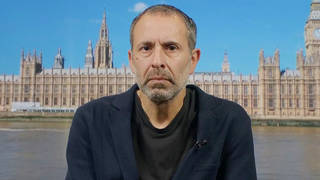
Guests
- Steve Phillipsfounder of Democracy in Color and senior fellow at Center for American Progress. He is a columnist at The Nation.
As the Democrats prepare for the 2018 midterms, some ask whether the party is making a mistake by prioritizing the pursuit of wavering white voters over investing in and inspiring African-American voters. Last week in Virginia, party leaders unveiled their new slogan—”A Better Deal”—and rolled out an agenda to win back working-class voters they lost to President Donald Trump in November. The rebranding effort comes as the Democrats have lost all four special congressional elections this year to Republicans. The defeats come despite Trump’s approval rating dipping to 36 percent. It’s the lowest six-month approval rating of a U.S. president in 70 years. We speak to Steve Phillips of Democracy in Color, who says the party has invested $750 million on the 2018 midterms without addressing the Democrats’ core problem of connecting with disillusioned voters. Phillips is the author of the New York Times best-selling book “Brown is the New White: How the Demographic Revolution Has Created a New American Majority.”
Transcript
JUAN GONZÁLEZ: We turn now to the future of the Democratic Party. Last week in Virginia, party leaders unveiled their new slogan—”A Better Deal”—and rolled out an agenda to win back the working-class voters they lost to President Donald Trump in November. This is Senate Minority Leader Chuck Schumer.
SEN. CHUCK SCHUMER: When you lose elections, as we did in 2014 and 2016, you don’t flinch, you don’t blink. You look in the mirror and ask, “What did we do wrong?” The number one thing we did wrong is not present a strong, bold economic agenda to working Americans so that their hope for the future might return again. Democrats have too often hesitated from directly and unflinchingly taking on the misguided policies that got us here, so much so that too many Americans don’t know what we stand for. Not after today.
President Trump campaigned on a populist platform, talking to working people. That’s why he won. But as soon as he got into office, he abandoned them, making alliance with the powerful, special interest, Koch brother-dominated, hard-right wing of the Republican Party, which appeals to the very wealthy, not the working people, leaving a vacuum on economic issues. We Democrats are going to fill that vacuum. Democrats will show the country we are the party on the side of working people. …
American families deserve a better deal, so this country works for everyone again, not just the elites, not just the special interests. Today, Democrats start presenting that better deal to the American people.
JUAN GONZÁLEZ: The Democratic Party’s rebranding effort comes as the party has lost all four special congressional elections this year to Republicans, including most recently in South Carolina and Georgia. These defeats come despite President Trump’s approval rating dipping to 36 percent as he passed the six-month mark of his presidency. That’s the lowest six-month approval rating of a U.S. president in 70 years.
AMY GOODMAN: Well, our next guest says Democratic Party committees and its allies are likely to spend more than $750 million on the 2018 midterms, without addressing the party’s core problems connecting with disillusioned voters.
For more, we go to San Francisco, California, where we’re joined by Steve Phillips, founder of Democracy in Color, also author of the New York Times best-selling book, Brown is the New White: How the Demographic Revolution Has Created a New American Majority. Phillips is a senior fellow at Center for American Progress, a columnist with The Nation and regular opinion contributor to The New York Times.
Steve Phillips, welcome to Democracy Now!
STEVE PHILLIPS: Thanks for having me.
AMY GOODMAN: So much has been made of what has happened just in the last week with the Republican Party—I mean, the failure of their healthcare bill to move forward, Donald Trump being criticized by the chief of the Boy Scouts for the speech that he gave, of course everything that’s happened in the White House, the expletive-laden rant of his new communications director, Anthony Scaramucci, and other issues, just in the last week. And you’re saying, forget all of this for a moment, let’s look at the state of the Democratic Party. They just have not been in focus. Talk about what you think is this billion-dollar blunder.
STEVE PHILLIPS: Yeah. So, the challenge the Democrats face is to focus on the math, and not on the myth, of what happened in 2016. And so, the myth is that all of these Democratic voters, all of these working-class white voters who had supported Obama, defected from the Democrats and then flocked to Donald Trump’s campaign and backed him, and that’s what the—that’s why Democrats lost, and that’s why they have to pursue them to be able to actually try to reassemble their power and get back into positions. But that’s not actually what happened, and it’s certainly not why they lost the election.
We had unprecedented—or, unprecedented in 20 years, black voter turnout drop-off. More than a million fewer black voters came out. And you had a splintering of the progressive white vote. And you had a larger increase of voters for Johnson and Stein—I sometimes call the JohnStein voters—than you did for Trump. And if you look in a place—Wisconsin is where it’s clearest. Trump got fewer voters in Wisconsin than Romney did. So it wasn’t like everybody flocked to him. It’s that the progressive votes splintered and was depressed. And that’s the challenge that the Democrats face, is how to reinspire, bring back out African-American voters, bring up Latino vote and bring back the whites who defected to third and fourth party. That’s the way to put back the Obama coalition. That’s the way to get back into power. But all this attempt to try to figure out how to woo voters who were drawn to one of the most racist, misogynistic, xenophobic campaigns in history is a fool’s errand.
JUAN GONZÁLEZ: Well, this whole question of the Democratic Party’s relationship to—especially to xenophobic voters has not—this is not the first time the party has grappled with it. I mean, if you go back to the ’50s and the ’60s, the Dixiecrats were a staple or a part of the Democratic Party. Then, when the Clinton era developed, there was the whole emphasis of the New Democrats to try to get conservative white voters, even as the nation keeps shifting, as you mention in your book, demographically, and the Democratic Party itself. So, how do you get these leaders to understand, to look at the future of America and not at the past?
STEVE PHILLIPS: Well, writing a book is not enough, as I have found out. So, it’s—there’s such a powerful incentive and default position that the thing to do is to go chase that shrinking sector of the population. I want to be clear: I’m not saying don’t pay attention to white people. I’m saying it’s the conservative white voter. You’re going—Democrats are going after the wrong white voters. There are progressive white voters, there are progressive working-class white voters, who need to be inspired and who need to be attracted and brought back. But the percentage of the population that the white working class comprises has shrunk dramatically. In the mid-1970s, the white working class was 74 percent of the electorate. In this last election, they were 43 percent of the electorate.
And so, to continue to chase a shrinking sector, at a time when the voters of color are expanding literally by the hour—every day, 7,000 new people of color are added to the population, versus 1,000 whites—is really, frankly, fairly incomprehensible, but it’s so embedded in the DNA that the most important voters are those white working-class voters. And the problem and the challenge is that all this money is going to be spent. Tens of millions of dollars, hundreds of millions of dollars are going to be spent on television ads, mainly, trying to pursue this sector of the population which is not receptive and, more importantly, is not necessary to win, at the same time as we have a majority population waiting to be spoken to, engaged, organized and mobilized.
AMY GOODMAN: So, just quoting from your New York Times op-ed piece, Steve Phillips, you write, “The country is under conservative assault because Democrats mistakenly sought support from conservative white working-class voters susceptible to racially charged appeals. Replicating that strategy would be another catastrophic blunder.” However, Bernie had an enormous appeal during the last campaign. Can you talk about who are the people that you think should be appealed to across the board? And take it right to Occupy Wall Street and the philosophy there.
STEVE PHILLIPS: Yeah, and that’s a good point, as well. And so, the coalition that elected and, more importantly, re-elected Obama—because Obama got 5 million fewer white votes in 2012—consist of overwhelming numbers of people of color, close to 80 percent of the voters of color, and then a meaningful minority of whites. Obama got 39 percent. Clinton got 37 percent.
And so, in a lot of ways, Bernie did show how to appeal particularly to the progressive white sector: an unapologetic campaign speaking to issues of economic inequality in this country, things like, you know, a $15 minimum wage, free access to higher education. Those issues resonated with people.
And it does tie back to the Occupy Wall Street piece. I mean, I talk in my book about doing a wealth tax on the top 1 percent in the country, that the top 1 percent, people who have $13 million a year—who have $13 million in assets, collectively, have $25 trillion. And so, if we did a 2 percent wealth tax, that would generate enough money to end poverty within this country. And so, you know, as a political matter, if you’re trying to get to 50 percent plus one of the votes, saying you’re with the 99 percent is actually not a bad place to start. So, I do think there’s a reluctance in the Democratic Party to actually go after Wall Street and go after the 1 percent to have them pay a fair share of taxes to be able to make the country better and to lift all of the boats.
JUAN GONZÁLEZ: And do you see anything hopeful in the new program that has been developed by the party leaders? I mean, there was, for instance, a reference—unusual for the party—of the continued concentration of wealth and of the development of corporate monopolies, an attack on that, as well.
STEVE PHILLIPS: Yeah, I mean, the broad-strokes framing are fine. And, you know, Schumer’s New York Times piece talks about higher wages, lower expenses, and retraining for jobs for the future, and so that’s a good framework. I think most encouraging in what they are putting forward is the $15 minimum wage, which was not the majority Democratic position, even in 2016. So, to see that the party is moving more aggressively toward that kind of a full-throated populism is a positive piece.
And yet, the underpinnings of the strategy—and I still think there’s a reluctance to enthusiastically embrace the communities that are under attack. And so, there’s a, you know, incredible attack right now on immigrants within this country, and that Trump has been deporting people as rapidly as possible and spreading fear among the immigrant community. There’s a whole question around: Is the DREAMers, the DACA, going to get reinstated or preserved? And so, there’s been a—there’s been a great deal of silence on the part of Democrats around this, who should be standing up and unapologetically saying that this is not the country that we believe in. But there’s a fear about being too strong on those issues, because they’re afraid of alienating conservative, white, working-class voters. And that plays directly into Trump’s hands.
AMY GOODMAN: And, Steve Phillips, I think you were just listening to the last segment that we were doing on President Trump’s speech actually encouraging police brutality, for which he has gotten enormous backlash from the heads of so many police organizations, as well. How does that fit into what you’re talking about here and how you feel the Democrats should respond?
STEVE PHILLIPS: Right. Well, clearly, over the past few years, one of the most powerful and visible movements within the country has been the Black Lives Matter movement around justice within the criminal—you know, reforming the criminal justice system. And yet, there’s a fear of being too closely aligned with that movement on the part of too many Democrats and progressives. Again, I talk in my book about the tyranny of the white swing voter. And so there’s a fear of alienating those folks, when, in fact, what they should—they should be standing up strongly for justice and accountability and transparency in our criminal justice system and on the part of law enforcement, so that it works in partnership with communities and is not an occupying force in the communities of color.
And what the Democrats fail to appreciate is that there are a lot of white people who believe in justice and equality, and in racial justice and equality. But the Democrats don’t believe there are enough of them. But, really, if you look at the numbers from Obama’s elections, there are enough of them, and those are the groupings which need to be inspired and spoken to and mobilized to reassemble the Obama coalition and take back power in the country.
AMY GOODMAN: Very quickly, you spent a lot of time talking about Democrats. What about third parties?
STEVE PHILLIPS: Well, I think what third parties can do is articulate a vision and create a pull that can pull the political debate to the left, instead of pulling it to the right, where it’s now actually going forward. So I think that’s some of what—you know, Bernie was not third-party per se, but that is a lot of what he did, is pulling the debate in a way that issues of economic inequality became more pronounced. And I think third and fourth parties can play that role.
AMY GOODMAN: Steve Phillips, we want to thank you so much for being with us, founder of Democracy in Color, author of the New York Times best-selling book, Brown is the New White: How the Demographic Revolution Has Created a New American Majority. We’ll also link to your op-ed piece in The New York Times.
Coming up, Trita Parsi on his new piece, “The Mask Is Off: Trump Is Seeking War with Iran.” Stay with us.












Media Options